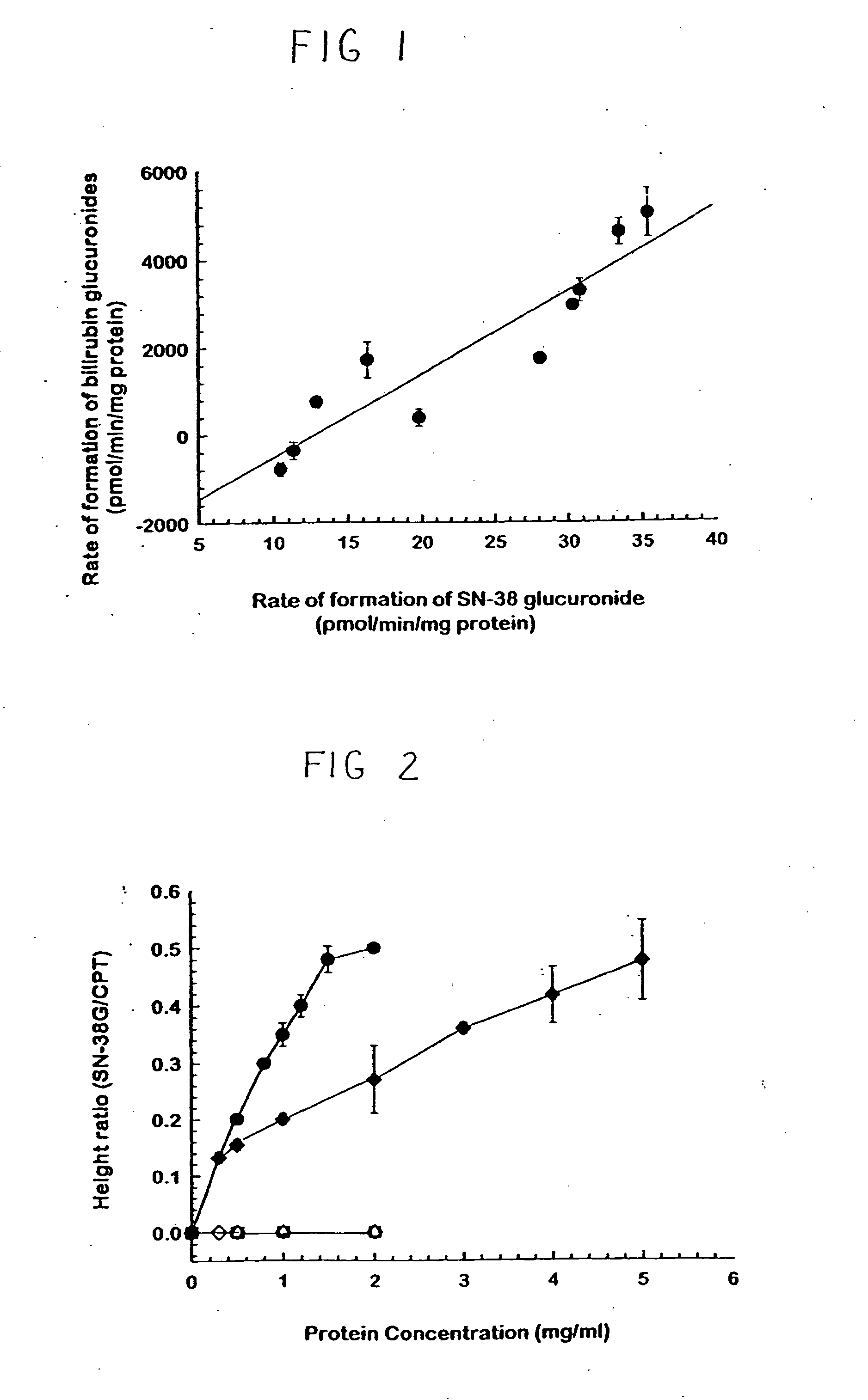Methods for detection of promoter polymorphism in a UGT gene promoter
a technology of promoter polymorphism and gene promoter, which is applied in the direction of transferases, enzymes, biochemical equipment and processes, etc., can solve the problems of major toxicity associated with tas-103 therapy, major problem of increased susceptibility to drug toxicity, and mild intermittent jaundi
- Summary
- Abstract
- Description
- Claims
- Application Information
AI Technical Summary
Problems solved by technology
Method used
Image
Examples
example 1
SN-38 Glucuronidation Assay
[0031] To investigate which UGT enzymes are responsible for SN-38 glucuronidation, the in vitro metabolism of SN-38 was measured using normal human and rat liver microsomes, as well as microsomes from Gunn rats, Gunn, C. H., J. Hered., 29:137-139 (1938), and patients with Crigler-Najjar type I (CN-1) syndrome. Liver microsomes were prepared from normal humans, CN-1 patients, normal rats, and Gunn rats and assayed for SN-38 glucuronidation. Microsomes from human liver samples medically unsuitable for liver transplantation were acquired under the auspices of the Washington Regional Transplant Consortium. In addition, microsomes were prepared by differential centrifugation methods. Purba, H. S., et al., Br. J. Clin. Pharmaocol. 23: 447-453, using human liver samples obtained with the approval of the Institutional Review Boards of institutions involved through the Liver Tissue Procurement and Distribution System. Investigations were performed with pooled micr...
example 2
AZT Glucuronidation Assay
[0035] To ensure the viability and functional enzymatic activity of the microsomal preparations, the UGT activity toward another substrate, AZT (3′-azido-3′-deoxythymidine) was investigated as a control. Liver microsomes from normal humans, CN-1 patients, normal rats, and Gunn rats were prepared as described above. Investigations were performed in pooled microsomes from normal rats, normal humans and Gunn rats, while microsomes from CN-1 patients were used individually.
[0036] Microsomes were preincubated with oleolyl lysophosphatidylcholine (OLPC) (0.8% wt / wt. OLPC / microsomal protein) at 4° C. for 20 minutes. The final reaction mixture contained 1 mg / ml preincubated microsomes, AZT (5 mM), MgCl2 (10 mM), 0.2 M Tris-HCl buffer (pH 7.3), and UDPGA (10 mM) in a final volume of 300 μl. After an incubation period of 1 hour at 37° C., the reaction was stopped with the addition of 30 μl of HCl. Proteins were removed after centrifugation at 10,500 g for 5 minutes ...
example 3
Glucuronidation Correlation Assay
[0038] To determine which UGT1 isoform is responsible for SN-38 glucuronidation, the correlation between the rates of formation of SN-38G and glucuronidation of bilirubin & PNP was investigated. PNP was chosen because planar phenols such as PNP and acetaminophen are glucuronidated predominantly by UGT1A6, See Burchell, et al., DNA cell biol., 10:487-494 (1991); Harding, et al., Proc. Natl. Acad. Sci. USA, 85:8381-8385 (1988), although several other isoforms such as UGT1A1, UGT1A4, and UGT2B15 have been reported to play a role in PNP glucuronidation in humans. See King, et al., Arch. Biochem. Biophys., 332:92-100 (1996); Green, et al., Drug Metab. Dispos., 23:299-302 (1995). Bilirubin was chosen because bilirubin has been previously shown to be glucuronidated by two isozymes of UGT1: UGT1A1 and UGT1A4. Ritter, et al., J. Biol. Chem., 266:1043-1047 (1991).
[0039] The formation of bilirubin mono- and diglucuronides was quantified using 14C-labeled UDPG...
PUM
| Property | Measurement | Unit |
|---|---|---|
| Fraction | aaaaa | aaaaa |
| Fraction | aaaaa | aaaaa |
| Fraction | aaaaa | aaaaa |
Abstract
Description
Claims
Application Information
 Login to View More
Login to View More - R&D
- Intellectual Property
- Life Sciences
- Materials
- Tech Scout
- Unparalleled Data Quality
- Higher Quality Content
- 60% Fewer Hallucinations
Browse by: Latest US Patents, China's latest patents, Technical Efficacy Thesaurus, Application Domain, Technology Topic, Popular Technical Reports.
© 2025 PatSnap. All rights reserved.Legal|Privacy policy|Modern Slavery Act Transparency Statement|Sitemap|About US| Contact US: help@patsnap.com

